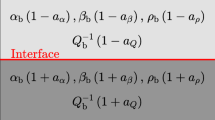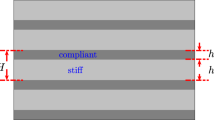Abstract
The quality factor Q is an important phenomenological parameter measured from seismic or laboratory seismic data and representing wave-energy dissipation rate. However, depending on the types of measurements and models or assumptions about the elastic structure, several types of Qs exist, such as intrinsic and scattering Qs, coda Q, and apparent Qs observed from wavefield fluctuations. We consider three general types of elastic structures that are commonly encountered in seismology: (1) shapes and dimensions of rock specimens in laboratory studies, (2) geometric spreading or scattering in body-, surface- and coda-wave studies, and (3) reflectivity on fine layering in reflection seismic studies. For each of these types, the measured Q strongly trades off with the (inherently limited) knowledge about the respective elastic structure. For the third of the above types, the trade-off is examined quantitatively in this paper. For a layered sequence of reflectors (e.g., an oil or gas reservoir or a hydrothermal zone), reflection amplitudes and phases vary with frequency, which is analogous to a reflection from a contrast in attenuation. We demonstrate a quantitative equivalence between phase-shifted reflections from anelastic zones and reflections from elastic layering. Reflections from the top of an elastic layer followed by weaker reflections from its bottom can appear as resulting from a low Q within or above this layer. This apparent Q can be frequency-independent or -dependent, according to the pattern of thin layering. Due to the layering, the interpreted Q can be positive or negative, and it can depend on source–receiver offsets. Therefore, estimating Q values from frequency-dependent or phase-shifted reflection amplitudes always requires additional geologic or rock-physics constraints, such as sparseness and/or randomness of reflectors, the absence of attenuation in certain layers, or specific physical mechanisms of attenuation. Similar conclusions about the necessity of extremely detailed models of the elastic structure apply to other types of Q measurements.











Similar content being viewed by others
References
Aki, K. (1980). Scattering and attenuation of shear waves in the lithosphere. Journal of Geophysical Research, 85, 6496–6504. doi:10.1029/JB085iB11p06496.
Aki, K., & Chouet, B. (1975). Origin of coda waves: Source, attenuation, and scattering effects. Journal of Geophysical Research, 80, 3322–3342. doi:10.1029/JB080i023p03322.
Aki, K., & Richards, P. G. (2002). Quantitative seismology (2nd ed.). Sausalito: University Science Books. ISBN 0-935702-96-2.
Bonar, D. C., & Sacchi, M. D. (2010). Complex spectral decomposition via inversion strategies. SEG Denver 2010 Annual Meeting, Denver. doi:10.1190/1.351310.
Calvet, M., & Margerin, L. (2013). Lapse-time dependence of coda Q: Anisotropic multiple-scattering models and application to the Pyrenees. Bulletin of the Seismological Society of America, 103, 1993–2010. doi:10.1785/0120120239.
Deng, W., & Morozov, I. B. (2016). Solid viscosity of fluid-saturated porous rock with squirt flows at seismic frequencies. Geophysics, 81(4), D395–D404. doi:10.1190/geo2015-0406.1.
Fuchs, K., & Müller, G. (1971). Computation of synthetic seismograms with the reflectivity method and comparison with observations. Geophysical Journal International, 23(4), 417–433.
Gardner, G., Gardner, L., & Gregory, A. (1974). Formation velocity and density—The diagnostic basics for stratigraphic traps. Geophysics, 39(6), 770–780.
Gochioco, L. M. (1991). Tuning effect and interference reflections from thin beds and coal seams. Geophysics, 56(8), 1288–1295. doi:10.1190/1.1443151.
Han, L., & Liu, C. (2015). Can we use wavelet phase change due to attenuation for hydrocarbon detection? In 85th Annual International Meeting, SEG, New Orleans, 2962–2966. doi:10.1190/segam2015-5890451.1.
Jackson, I., & Paterson, M. S. (1993). A high-pressure, high-temperature apparatus for studies of seismic wave dispersion and attenuation. Pure and Applied Geophysics, 141(2/3/4), 445–466. doi:10.1007/978-3-0348-5108-4_12.
Kjartansson, E. (1979). Constant-Q wave propagation and attenuation. Journal of Geophysical Research, 84, 4737–4748. doi:10.1029/JB084iB09p04737.
Lakes, R. (2009). Viscoelastic materials. Cambridge: Cambridge University Press. ISBN 978-0-521-88568-3.
Lines, L., Vasheghani, F., & Treitel, S. (2008). Reflections on Q. CSEG Recorder, 34, 36–38.
Lines, L., Wong, J., Innanen, K., & Vasheghani, F. (2014). Research note: Experimental measurements of Q-contrast reflections. Geophysical Prospecting, 62, 190–195. doi:10.1111/1365-2478.12081.
Mashinskii, E. (2017). Dynamic microplasticity manifestation in consolidated sandstone in the acoustical frequency range. Geophysical Prospecting, 65, 266–279. doi:10.1111/1365-2478.12398.
Morozov, I. B. (2010). On the causes of frequency-dependent apparent seismological Q. Pure and Applied Geophysics, 167, 1131–1146. doi:10.1007/s00024-010-0100-6.
Morozov, I. B. (2015). Effective moduli and Poisson’s ratios in poroelasticity. Canadian Journal of Exploration Geophysics, 40, 21–34.
Morozov, I. B., & Baharvand Ahmadi, A. (2015). Taxonomy of Q. Geophysics, 80(1), T41–T49. doi:10.1190/GEO2013-0446.1.
O’Doherty, R., & Anstey, N. A. (1971). Reflections on amplitudes. Geophysical Prospecting, 19(3), 430–458. doi:10.1111/j.1365-2478.1971.tb00610.x.
Pimienta, L., Borgomano, J., Fortin, J., & Guéguen, Y. (2016). Modelling the drained/undrained transition: Effect of the measuring method and the boundary conditions. Geophysical Prospecting, 64(4), 1098–1111.
Pimienta, L., Fortin, J., & Guéguen, Y. (2015). Experimental study of Young’s modulus dispersion and attenuation in fully saturated sandstones. Geophysics, 80(5), L57–L72.
Quan, Y., & Harris, J. M. (1997). Seismic attenuation tomography using the frequency shift method. Geophysics, 62, 895–905. doi:10.1190/1.1444197.
Richards, P. G., & Menke, W. (1983). The apparent attenuation of a scattering medium. Bulletin of the Seismological Society of America, 75, 1005–1021.
Ricker, N. (1953). The form and laws of propagation of seismic wavelets. Geophysics, 18, 10–40. doi:10.1190/1.1437843.
Santos, L. T., & Tygel, M. (2004). Impedance-type approximations of the P–P elastic reflection coefficient: Modeling and AVO inversion. Geophysics, 69, 592–598.
Tonn, R. (1991). The determination of the seismic quality factor Q from VSP data: A comparison of different computational methods. Geophysical Prospecting, 39, 1–27. doi:10.1111/j.1365-2478.1991.tb00298.x.
Wang, S., Yang, D., Li, J., & Song, H. (2015). Q factor estimation based on the method of logarithmic spectral area difference. Geophysics, 80(6), V157–V171. doi:10.1190/geo2014-0257.1.
White, R. (1992). The accuracy of estimating Q from seismic data. Geophysics, 57(11), 1508–1511. doi:10.1190/1.1443218.
White, J. E., Mikhaylova, N. G., & Lyakhovitsky, F. M. (1975). Low-frequency seismic waves in fluid-saturated layered rocks. The Journal of the Acoustical Society of America, 57(S1), S30–S30. doi:10.1121/1.1995164.
Zhang, C., & Ulrych, T. J. (2002). Estimation of quality factors from CMP records. Geophysics, 67, 1542–1547. doi:10.1190/1.1512799.
Acknowledgements
W. Deng was supported by the Scholarship Council, P. R. China. We are grateful to Dr. Alexander Minakov and anonymous reviewers whose questions and comments have helped improving this manuscript.
Author information
Authors and Affiliations
Corresponding author
Rights and permissions
About this article
Cite this article
Deng, W., Morozov, I.B. Trade-off of Elastic Structure and Q in Interpretations of Seismic Attenuation. Pure Appl. Geophys. 174, 3853–3867 (2017). https://doi.org/10.1007/s00024-017-1581-3
Received:
Revised:
Accepted:
Published:
Issue Date:
DOI: https://doi.org/10.1007/s00024-017-1581-3




